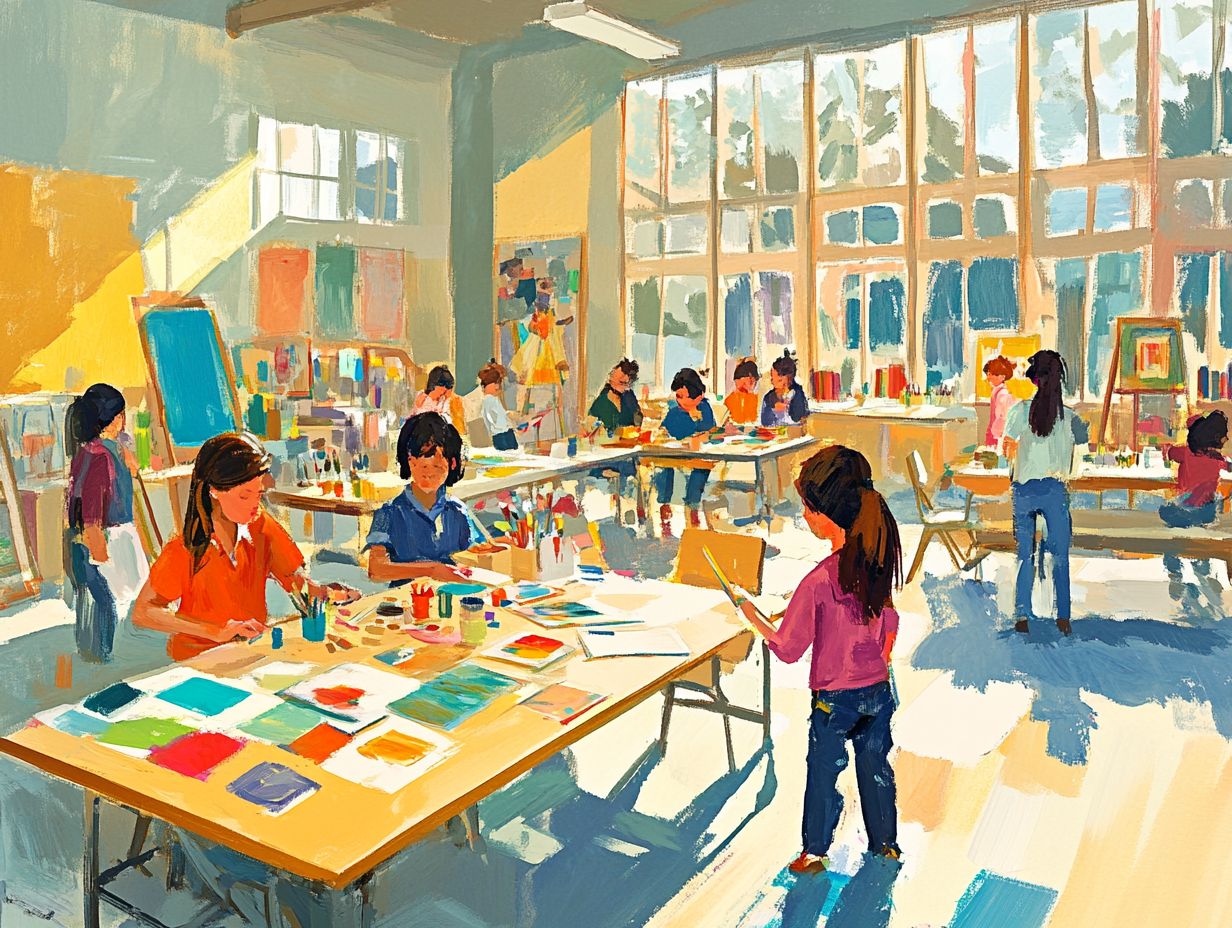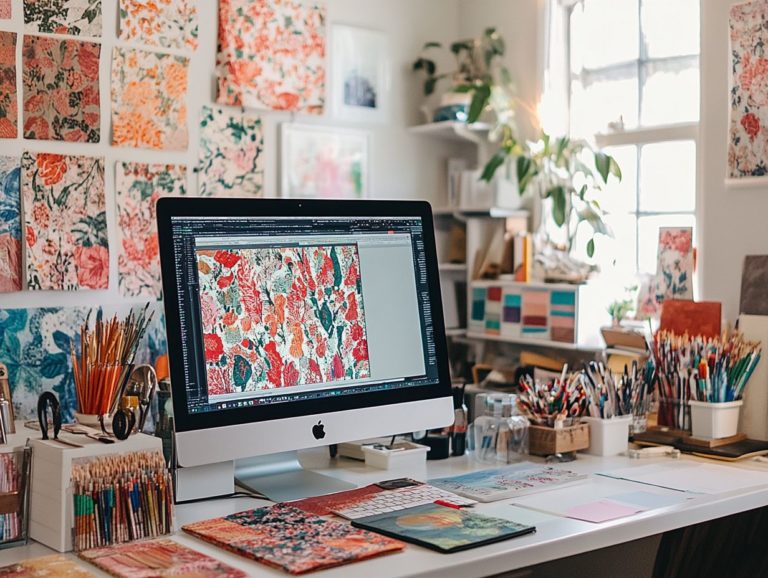The Importance of Creativity in Education
Creativity holds a vital position in education, influencing not just academic achievement but also personal development.
When you weave creativity into the learning experience, you unlock a multitude of benefits enhancing problem-solving abilities, nurturing self-expression, and boosting confidence.
Let s tackle the challenges educators face head-on and explore practical strategies and innovative tools that can cultivate a more imaginative classroom atmosphere.
Embrace the transformative power of creativity in education, enriching the journeys of both students and teachers.
Contents
- Key Takeaways:
- The Benefits of Incorporating Creativity in Education
- Challenges in Promoting Creativity in Education
- Ways to Foster Creativity in the Classroom
- The Role of Technology in Promoting Creativity in Education
- Frequently Asked Questions
- What is the importance of creativity in education?
- How does creativity enhance learning in education?
- Can creativity be taught in an educational setting?
- Why is it important for educators to incorporate creativity in their teaching methods?
- What are the benefits of incorporating creativity in education?
- How can parents support the development of creativity in their children’s education?
Key Takeaways:

- Creativity is an essential aspect of education, enhancing learning and problem-solving skills.
- Incorporating creativity in the classroom improves self-expression and boosts students’ confidence.
- While promoting creativity may face challenges, various teaching strategies and activities can foster it effectively.
Start incorporating creativity in your classroom today!
Defining Creativity and Its Role in Education
Creativity is an important part of education, influencing not just academic success but also emotional development and the role of creativity in personal development and critical thinking skills.
It encompasses various elements, such as problem-solving and artistic expression, enabling you to navigate complex challenges and express yourself meaningfully.
As education evolves, grasping and nurturing creativity becomes vital for preparing you for a world that values innovative solutions and interdisciplinary approaches.
This dynamic capability involves your ability to think divergently, generate fresh ideas, and connect seemingly unrelated concepts.
By fostering your creativity, educators help cultivate cognitive skills that enhance your decision-making and adaptability traits crucial in our interconnected global society.
As you engage in creative projects, you learn to tackle challenges with resilience and an open mind, laying the groundwork for a lifetime of learning.
Nurturing your creativity also instills a sense of responsibility and empathy, encouraging you to become a proactive global citizen who contributes positively to your community.
The Benefits of Incorporating Creativity in Education
Incorporating creativity into education brings a wealth of benefits that can profoundly elevate your learning experiences.
It nurtures teamwork and emotional intelligence while promoting self-esteem and resilience through hands-on learning and project-based assessments.
When students engage in creative projects, they cultivate collaborative problem-solving skills crucial for real-world applications, resulting in a richer, more fulfilling school experience.
Enhanced Learning and Problem-Solving Skills
Enhanced learning and problem-solving skills stand out as significant benefits of weaving creativity into educational practices.
This approach encourages you to think critically and engage more deeply with the material.
By diving into inquiry-based learning engaging with material through asking questions you sharpen your cognitive abilities and enhance your capacity to tackle complex challenges creatively.
Consider collaborative projects that demand brainstorming innovative solutions; these can significantly boost your teamwork skills and cultivate an environment where diverse ideas flourish.
Engaging in activities like role-playing or conducting experiments allows you to explore concepts firsthand, reinforcing your understanding through active participation.
Incorporating tools such as mind-mapping software or creative writing exercises can ignite your curiosity, inspiring you to ask questions and seek answers independently.
These strategies not only make the learning experience more captivating but also equip you with critical thinking skills essential for solving real-world problems.
In conclusion, creativity is not just an added bonus in education; it is a fundamental component that shapes engaged, innovative learners ready to face the future.
Improved Self-Expression and Confidence

Improved self-expression and confidence are essential benefits that emerge from nurturing creativity in educational environments. By fostering these qualities, you empower yourself to articulate your thoughts and emotions with clarity and conviction.
This creative outlet not only enhances your emotional development but also encourages you to embrace your unique voice through arts integration and constructive peer feedback. Such approaches provide you with opportunities to explore a variety of artistic expressions whether through visual arts, music, or drama allowing you to communicate experiences that words alone may not fully convey.
Engaging in peer feedback sessions cultivates a safe, collaborative atmosphere where you feel valued and understood. This ultimately bolsters your self-esteem. When you see your ideas appreciated by others, it reinforces your belief in your own capabilities, nurturing a resilient sense of identity.
The synergy of creativity and community works together to boost emotional awareness. This builds lasting confidence that goes beyond the classroom.
Challenges in Promoting Creativity in Education
Fostering creativity in education is crucial and can transform learning experiences! However, several challenges stand in the way of its seamless integration into traditional educational frameworks.
Hurdles include rigid school cultures and outdated testing methods that favor standardized testing over genuine creative exploration.
To incorporate creativity effectively, educators must seek innovative solutions that harness the power of educational technology, enhancing student engagement and fostering a vibrant culture of creativity.
Obstacles and Solutions
Recognizing and addressing obstacles to creativity in education is essential for developing effective solutions that foster a more enriching learning experience.
Challenges such as inflexible curriculum design and insufficient project management can stifle creativity. However, embracing cross-subject learning can lead to better educational outcomes.
You often encounter constraints like standardized testing pressures and limited resources, which can further hinder innovative thinking. By incorporating strategies such as collaborative project-based learning and encouraging critical thinking, you can equip your students with the tools they need to think outside the box.
Creating an environment that values exploration allows your students to engage deeply with material across various subjects. This facilitates a genuine, hands-on understanding of the connections between different fields.
Ways to Foster Creativity in the Classroom
Fostering creativity in your classroom demands a multifaceted approach that includes innovative teaching strategies and engaging interactive activities, all tailored to spark student collaboration and hands-on learning.
A thoughtfully designed curriculum is crucial; it lays the foundation for an environment where students feel empowered to explore their personal interests and unlock their creative potential.
Teaching Strategies and Activities

Effective teaching strategies that focus on creativity often involve engaging projects, interactive activities, and collaborative problem-solving exercises. These not only enhance the ability to understand and manage emotions but also foster skill development among students.
By adopting these approaches, you encourage learners to actively engage, nurture their creative thinking, and develop resilience when facing challenges.
When you integrate these strategies into the curriculum, you craft an environment where students feel secure expressing their ideas and exploring their abilities.
For instance, utilizing group art projects enables students to communicate visually while appreciating diverse perspectives.
Incorporating role-playing exercises can also cultivate empathy and enhance teamwork skills, leading to a deeper understanding of social dynamics.
When you give students the freedom to brainstorm solutions to real-world problems, they sharpen their critical thinking abilities and build confidence in their decision-making skills.
This approach ultimately fosters higher levels of engagement and satisfaction in the learning process.
The Role of Technology in Promoting Creativity in Education
The significance of technology in fostering creativity within the education system is immense.
It presents a rich array of innovative tools that not only facilitate creative projects but also enhance students’ digital literacy.
Integrating educational technology into the curriculum offers real-world applications.
This creates an environment that nurtures and encourages creative exploration.
Innovative Tools and Resources
Modern tools and resources, from dynamic digital platforms to engaging hands-on materials, are vital for fostering creativity in education.
These resources empower you to engage in collaborative problem-solving.
They inspire creative projects that ignite innovative thinking.
For example, platforms like Padlet and Google Workspace enable you to brainstorm ideas collectively, share multimedia files, and organize your thoughts in a visually appealing way.
Resources such as coding kits and robotics sets provide hands-on experiences.
They bridge the gap between theoretical knowledge and practical application.
By integrating these tools into your learning experience, you can create an environment where you sharpen your digital skills.
You will also develop critical competencies like teamwork and effective communication, which are essential for navigating today s interconnected world.
Frequently Asked Questions
What is the importance of creativity in education?

Creativity is vital! It empowers students to think differently, solve problems, and generate unique ideas.
This passion for learning fuels critical thinking skills.
How does creativity enhance learning in education?
Creativity enhances learning by making it more engaging, stimulating, and enjoyable for students.
It allows them to connect with the subject matter in a personal way and retain information better.
Can creativity be taught in an educational setting?
Yes, creativity can be taught and encouraged in an educational setting.
By providing opportunities for creative expression, using different teaching methods, and fostering a supportive environment, students can develop and enhance their creative skills.
Why is it important for educators to incorporate creativity in their teaching methods?
Incorporating creativity in teaching methods allows educators to cater to the diverse learning styles of their students.
This creates a more inclusive learning environment and helps develop critical thinking, problem-solving abilities, and promotes a lifelong love for learning.
What are the benefits of incorporating creativity in education?
Some benefits of incorporating creativity in education include improved academic performance, increased motivation and engagement, enhanced problem-solving skills, and the development of innovative thinking abilities.
How can parents support the development of creativity in their children’s education?
Parents can support creativity in their children’s education by encouraging them to engage in creative activities.
Exposing them to different forms of art and media helps provide a supportive and open-minded environment to express their ideas.






